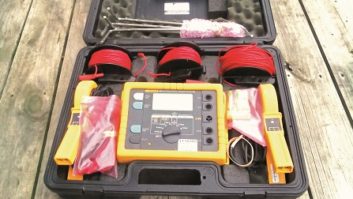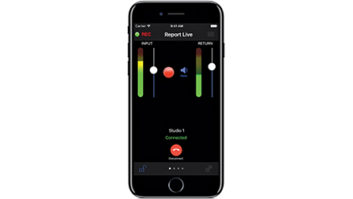Lightning Explained, Part 2
Jul 7, 2011 12:00 PM, By Amir Rizk
The scientific views expressed in this article are those of Dr. Farouk A.M. Rizk as explained by Amir Rizk. Dr. Farouk Rizk is the former VP (Research Laboratories), Hydro Quebec, and former Scientific Director at IREQ. Amir Rizk (B.Sc., phys, MBA) is VP of Lightning Electrotechnologies Inc and a student of Dr. Rizk. Any technical matters dealing with lightning protection adhered to previously published, peer reviewed material.
The good
When it comes to issues like the minimum conductor thickness for lightning currents, grounding and bonding, the information contained in standards such as IEC 62305 and NFPA 780 are well founded in science and unlikely to change in the foreseeable future.
However when it comes to something as fundamental as the shape of a lightning rod (air terminal) and where it should be placed, there is controversy.
The not so good
During the process that rejected a proposal to issue an NFPA Standard for Early Streamer Emission (ESE) lightning protection technology, some interesting issues were raised. (More on ESEs below). The Bryan Panel, deemed independent, reliable and respected by the NFPA Standards Council, produced a report that concluded there was no technical validation for ESE technology and in addition, it also raised questions as to whether or not technical validation existed for conventional lightning protection systems.
In response to this, among others, a report in support of conventional lightning protection was produced entitled, “The Basis of Conventional Lightning Protection Technology: A Review of the Scientific Development of Conventional Lightning Protection Technologies and Standards”. This report was prepared by the Federal Interagency Lightning Protection users Group 2001, which to the objection of some, included members of the NFPA 780 Technical Committee. This document produced no new research but drew a different conclusion from the Bryan Panel Report.
The document was deemed sufficient by the NFPA Standards Council to maintain the status of NFPA 780, although its decision stated: “The Council has not attempted to independently review each piece of literature cited in the report nor has the council attempted to independently answer the question of technical validity of NFPA 780.”
A real problem with the prescriptions in NFPA 780 is that they ignore the role played by the grounded structure to be hit. They assume a constant striking distance or an equal probability of a direct hit to the ground, to the corner of a tall building, the edge of a building, etc. This defies observation and theory. The result is a practice of blindly placing a rod every 20′ without consideration for building height or topology. This can be wasteful and excessive in terms of the use of materials while still not offering adequate protection.
— continued on page 2
Lightning Explained, Part 2
Jul 7, 2011 12:00 PM, By Amir Rizk
The millisecond-by-millisecond account of a lightning strike provided in Part I was based on modeling of a competition between the building corner and a 0.3m rod installed as per code to protect that corner. It was found that the corner had a higher probability of being struck. This occurs with prospective return stroke currents as low as 12kA and the situation gets worse as the size of the strike increases.
In such cases, the installation of rods as per the standards on such structures has little to no influence on the protection provided. The entire protection function is performed by the grounding and down-conductor system that collects a portion of the lightning current after direct attachment has occurred to the structure itself and not to the rods. This still limits damage but the stray portions of the lightning current degrades infrastructure and enhances electromagnetic disturbances. It would be far better if the entire lightning current was distributed and conducted to ground via the lightning protection system, but this requires that the lightning rods are struck directly.
The bad
There exists a whole class of products called charge transfer systems or dissipators. They all use large numbers of sharp conductive points and the explanation as to the mode of operation offered by their proponents keeps changing. First it was claimed that they could prevent lightning from occurring by discharging the clouds, but that was invalidated. Then it was claimed that the charge of the descending leader could be neutralized, but that was invalidated. They still claim that these devices can dissipate, bleed off or otherwise remove the induced image charge produced by the cloud charges and change the potential between the clouds and the ground.
This is of course impossible since induced image charges are just that, induced images. So long as the inducing charges that are the source of the image remain, the resulting image remains. Also altering the voltage between the clouds and the ground would necessarily mean changing the potential of the clouds since, unless hit by lightning, ground remains at ground potential. Changing the potential of the clouds is not an option.
However, rather than bleeding off or transferring any image charge, something else is happening here that is of some scientific interest.
It has been observed that conventional rods are occasionally bypassed and lightning attaches in their immediate vicinity. As well, in experimental field studies with real lightning, it was observed that in head-to-head competition, blunt rods are favored to be struck when compared to sharp rods. The results were most recently explained by a mechanism known as “space charge shielding”. (More on space charge shielding in Part 3.)
— continued on page 3
Lightning Explained, Part 2
Jul 7, 2011 12:00 PM, By Amir Rizk
It is not unreasonable to assume that charge transfer systems or dissipation devices produce the same effect as sharp rods. Since both would produce charges via the same mechanism: streamers. And since increasing the number of sharp conductive points does not proportionally increase the charge produced, as the points interact. Any shielding effect produced by these point discharge based devices is the same shielding effect that causes conventional lightning rods to occasionally fail and should thus occur just as frequently. Any protective effect will be sporadic and extremely limited in range and may only be significant on very tall towers in excess of 100m, where upward lightning is a real possibility.
The ugly
The basic premise behind the Early Streamer Emission (ESE) lightning rods is that by producing streamers earlier than would have naturally occurred, this will result in an upward connecting leader earlier. Since the leader will have this additional time to propagate it will cover greater distances and provide a larger zone of protection.
Despite having the support of The French Standard NF C17-102, the very concept simply doesn’t make sense.
Assuming it is possible to create the upward connecting leader early, the possibility of any gained advantage would only be true if the upward leader always moved at a constant speed. But in reality the speed of the upward leader is dictated by its proximity to the descending leader. If you launch the leader early, this necessarily means that the descending leader was farther away. Therefore the upward leader will simply move more slowly, if at all, and so it is far from clear that any advantage can be gained.
More critical analysis reveals that the attempt to produce the upward leader early may actually impede the ability to intercept a strike.
Despite the lack of any technical basis for ESE technology they continue to find customers. In part because the overall system installation, including all connections and conductors, is cheaper than the practices recommended by code and furthermore, those same code recommendations are known to occasionally fail.
It is expected that an ESE will function very much like a sharp-tipped rod installed in the same location and collect some percentage of strikes. This is consistent with all the reported failures as well as all the reported successes.
— continued in Part 3
Lightning Explained, Part 1
Part one of this three-part series explains the basics of lightning and its energy potential….
Lightning Explained, Part 3
Part tree of this three-part series looks at currents methods of lightning protection….
References
1. NFPA International, Standards Council Decision (Long Form): D301-26
2. F.A.M. Rizk, “Modeling of Lightning Exposure of Buildings and Massive Structures” IEEE Trans. On Power Delivery, Vol. 24, No.4, pp. 1987-1998 October 2009
3. M.A. Uman and V.A. Rakov, “A Critical review of Nonconventional Approaches to Lightning Protection” American Meteorology Society, December, 2002
4. C.B. Moore, W. Rison, J. Mathis and G. Aulich, “Lightning rod improvement studies”, Journal of Applied Meteorology, Vol.39, pp.593-609, 2000
5. F.A.M. Rizk, “Modeling of Lightning Exposure of Sharp and Blunt Rods” IEEE Trans. On Power Delivery, Vol. 25, No.4, pp 3122 -3132, October, 2010
6. D. Mackerras, M. Darveniza, A.C. Liew, ” Review of claimed enhanced lightning protection of buildings by early streamer emission air terminals”, IEE Proc.-Sci Meas. Technol., Vol. 144, No. 1. January 1997
7. I.D. Chalmers FIEE, J.C. Evans and W.H. Siew MIEE, IEE Proc.-Sci Technol, Vol. 146, No. 2, March, 1999
8. N. Knudsen, F. Iliceto, “Flashover tests on large air gaps with dc voltages and with switching surges superimposed on dc voltage”, IEEE Trans., Vol. PAS-89, No.5/6, pp. 781-788, May/June 1970
9. F.A.M. Rizk, “Rocket-Triggered Lightning: Modeling of Trigger-Wire Corona Effects” International Conference on Lightning Protection, ICLP, Cagliari, Italy, September 2010
10. F.A.M. Rizk, “Modeling of lightning Incidence to tall structures.”, IEEE Trans., Vol. PWRD-9, pp. 162-171, Jan. 1994
11. US PATENT 1,266,175
12. F.A.M. Rizk, “Analysis of Space charge Generating Devices for Lightning Protection: Performance in Slow Varying Fields”, IEEE Trans. On Power Delivery, Vol. 25, No. 3, pp. 1996-2006, July 2010
13. F.A.M. Rizk, “Exposure of overhead conductors to direct lightning strikes: Modeling of positive streamer Inhibition”, IEEE Trans. on Power Delivery, Vol. 26, No. 2, pp. 1156 – 1165, April 2011





